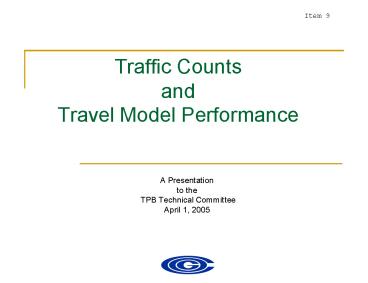Traffic Counts and Travel Model Performance - PowerPoint PPT Presentation
1 / 20
Title:
Traffic Counts and Travel Model Performance
Description:
DDOT, MDSHA, VDOT, Local Jurisdictions. AADT (MD) / AAWDT (DC and VA) ... Link AAWDT Traffic Volume Estimate only to the network link where the Program or ... – PowerPoint PPT presentation
Number of Views:50
Avg rating:3.0/5.0
Title: Traffic Counts and Travel Model Performance
1
Traffic Counts and Travel Model Performance
Item 9
- A Presentation
- to the
- TPB Technical Committee
- April 1, 2005
2
Traffic Counts and Model Evaluation
- The Yardstick of Model Performance
- Regional/Jurisdictional VMT
- Screenline/Cutline Crossings
- Air Quality Requirements
- VMT Tracking
- Emission Budgets
- Increasing Specificity Sought
- AADT, AAWDT, Seasonal, Time of day,
Classification, etc.
3
Model Performance is Relative
- Performance is an Estimated-to-Observed Ratio
- Regional, Subregional, Jurisdiction, Screenline,
Link, - Performance Depends on Accuracy of Both Estimated
and Observed Figures - A Balanced Understanding of Both Estimated and
Observed Figures is Critical to Validation
4
Traffic Counts in the Region
- Highway Performance Monitoring System (HPMS) is
Primary Source of Count Data - DDOT, MDSHA, VDOT, Local Jurisdictions
- AADT (MD) / AAWDT (DC and VA)
- Coding Counts in the Highway Network
- Historically a Manual Process Using Count
Books/Maps - More Recently Electronic Transfer Using
Georeferenced Count Data Bases and COGs
Transportation Data Clearinghouse - Data Used as is Maximum Link Coverage Sought
5
HPMS Overview
- Samples Designed for Statewide Traffic Estimates
- Permanent Counting Stations, Continuous Operation
- Program Count Locations Short Count Duration,
3-year Collection Cycle - Adjustments Applied to Counts
- Current-year Program Counts Annualized
- Non-Current Year Program Counts Adjusted to
Current Year - Partially Operational Permanent Counts Annualized
- Manual Adjustments made to compensate for
Equipment Failure, Construction, Safety Issues,
etc. - Adjustments based on Perm.Counts Statewide
6
Observations on the HPMS
- HPMS is not a count of traffic, per se-- HPMS is
an annualized traffic volume estimate based on a
statewide sample of a limited number of
locations. - A Case Can be Made Model Performance expressed
as an Estimated-to-Observed Ratio Should be
Considered as an Estimated-to-Estimated Ratio - When HPMS data is used for a specific
metropolitan area, data noise is a potential
issue.
7
Issues for Transportation Modeling
- Highway Network is an Approximation of the
Physical Roadway System - Resolving AADT Figures to AAWDT is Approximate
- Directionality of Counts is Suppressed With HPMS
Data - Ground Count Highway Network Coding Practices Can
Also Introduce Noise/Bias Into the Performance
Statistics
8
Daily VMT Over Timefor the Washington Region By
State
9
Time Series VMT Changefor the Washington Region
By State
10
Yr 2000 Validation Freeways RMSE Summary
11
Updated Traffic Volume Estimates for V2.1.D Model
Performance Tests
- Review Traffic Volume Data/ Estimates for all
jurisdictions in the metropolitan Washington
region (MSA). - Link AAWDT Traffic Volume Estimate only to the
network link where the Program or Permanent
Counting Station was located (i.e. no carrying
forward or averaging volume estimates for
adjacent links). - Identify all Program and Permanent Counting
station locations where actual traffic count data
was collected in Year 2000. - Identify all Permanent Counting Stations that
were operational in Year 2000.
12
All Program and Permanent Counting Locationswith
Actual or Factored Daily Traffic Volume Estimates
for Year 2000
13
All Program and Permanent Counting Locationswith
Actual Traffic Count Data Collected in Year 2000
14
All Operational Permanent Counting Station
Locations in Year 2000
15
Performance Test Results
16
Validation E/O Scatterplots11,004 Observations
17
Permanent /Actual Factored Program Counts
2,953 Observations
18
Permanent /Actual Program Counts 1,194
Observations
19
Permanent Count Stations68 Observations
20
Conclusions
- Model Performance Improves with Higher Quality
Counts - Metropolitan areas using statewide counting
program data should expect count accuracy
limitations-- especially multi-state areas.
Consider metropolitan samples? - Expect scatterplot outliers, seek explanations
- Performance problems does not equate to model
problems.































